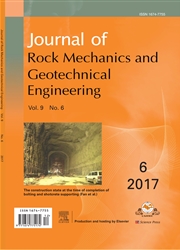

 中文摘要:
中文摘要:
Water-bearing rocks exposed to freezing temperature can be subjected to freezeethaw cycles leading tocrack initiation and propagation, which are the main causes of frost damage to rocks. Based on theGriffith theory of brittle fracture mechanics, the crack initiation criterion, propagation direction, andcrack length under freezing pressure and far-field stress are analyzed. Furthermore, a calculation methodis proposed for the stress intensity factor (SIF) of the crack tip under non-uniformly distributed freezingpressure. The formulae for the crack/fracture propagation direction and length of the wing crack underfreezing pressure are obtained, and the mechanism for coalescence of adjacent cracks is investigated.In addition, the necessary conditions for different coalescence modes of cracks are studied. Using thetopology theory, a new algorithm for frost crack propagation is proposed, which has the capability todefine the crack growth path and identify and update the cracked elements. A model that incorporatesmultiple cracks is built by ANSYS and then imported into FLAC3D. The SIFs are then calculated using aFISH procedure, and the growth path of the freezing cracks after several calculation steps is demonstratedusing the new algorithm. The proposed method can be applied to rocks containing fillings such asdetritus and slurry. 2014 Institute of Rock and Soil Mechanics, Chinese Academy of Sciences. Production and hosting byElsevier B.V. All rights reserved.
 英文摘要:
英文摘要:
Water-bearing rocks exposed to freezing temperature can be subjected to freezeethaw cycles leading tocrack initiation and propagation, which are the main causes of frost damage to rocks. Based on theGriffith theory of brittle fracture mechanics, the crack initiation criterion, propagation direction, andcrack length under freezing pressure and far-field stress are analyzed. Furthermore, a calculation methodis proposed for the stress intensity factor (SIF) of the crack tip under non-uniformly distributed freezingpressure. The formulae for the crack/fracture propagation direction and length of the wing crack underfreezing pressure are obtained, and the mechanism for coalescence of adjacent cracks is investigated.In addition, the necessary conditions for different coalescence modes of cracks are studied. Using thetopology theory, a new algorithm for frost crack propagation is proposed, which has the capability todefine the crack growth path and identify and update the cracked elements. A model that incorporatesmultiple cracks is built by ANSYS and then imported into FLAC3D. The SIFs are then calculated using aFISH procedure, and the growth path of the freezing cracks after several calculation steps is demonstratedusing the new algorithm. The proposed method can be applied to rocks containing fillings such asdetritus and slurry. 2014 Institute of Rock and Soil Mechanics, Chinese Academy of Sciences. Production and hosting byElsevier B.V. All rights reserved.
 同期刊论文项目
同期刊论文项目
 同项目期刊论文
同项目期刊论文
 期刊信息
期刊信息
